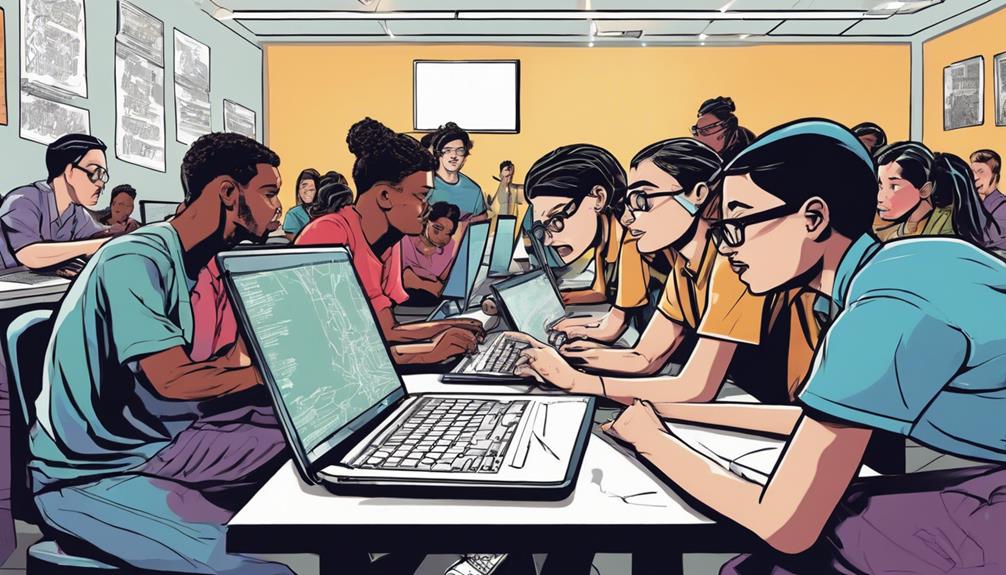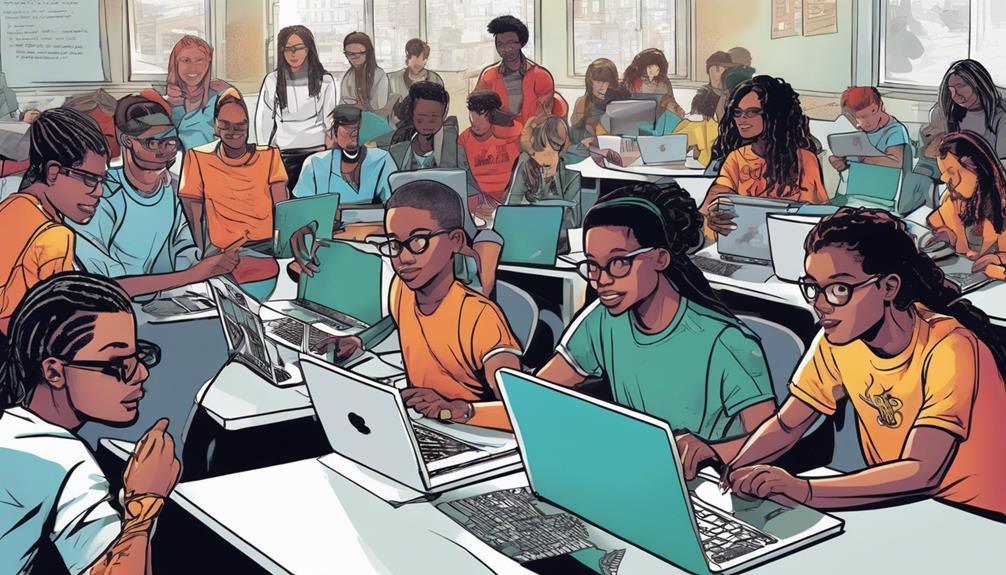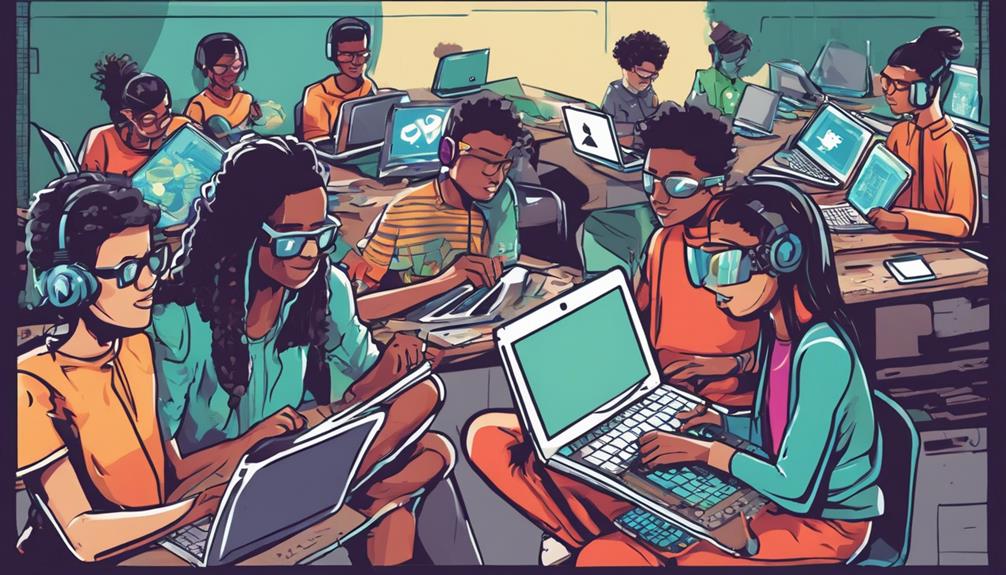Unlocking the power of coding in education is like discovering a treasure chest of opportunities for students in the digital era. Coding stimulates critical thinking, enhances problem-solving skills, and nurtures computational thinking processes, fostering an understanding of logical sequences and algorithms. Not just that, it also opens pathways to lucrative careers in software development, cybersecurity, and data analysis, offering students a chance to make a significant impact in the tech industry. By problem-solving through coding, students enhance their logical and analytical skills, encouraging innovative solutions and cultivating a growth mindset. Stay tuned to reveal how coding enhances personal growth, educational methods, and digital literacy for students.
Key Takeaways
- Enhances critical thinking and problem-solving skills.
- Fosters a growth mindset and resilience in students.
- Integrates technology for educational enhancement.
- Empowers students to innovate and collaborate.
- Prepares students for lucrative coding careers in tech.
Cognitive Benefits of Coding

Engaging in coding activities enhances students' cognitive abilities by stimulating critical thinking, problem-solving skills, and computational thinking processes. Through coding, students are challenged to think analytically, strategically, and creatively. This process not only sharpens their problem-solving skills but also encourages them to approach challenges with a systematic mindset.
By breaking down complex problems into smaller, more manageable parts, students learn to tackle issues methodically and efficiently. Additionally, coding fosters a deeper understanding of logical sequences, patterns, and algorithms, further enhancing their cognitive capabilities.
Pathways to Coding Careers

Discovering the diverse pathways to coding careers reveals a plethora of opportunities in technology-driven industries for individuals with proficient coding skills.
- Software Development: Begin an exciting journey to create innovative programs, apps, and software solutions that shape the digital landscape.
- Cybersecurity Specialist: Immerse yourself in the world of cybersecurity, protecting crucial information and systems from cyber threats and attacks.
- Data Analyst: Explore the domain of data analysis, uncovering valuable insights and trends to drive informed decision-making in various industries.
These pathways offer not only lucrative prospects but also the chance to make a significant impact in the ever-evolving tech industry.
Problem-Solving Through Coding

Enhancing problem-solving abilities through coding involves leveraging logical thinking and creativity to find the most effective solutions efficiently. Coding challenges students to approach problems methodically, breaking them down into smaller, manageable parts and developing step-by-step solutions. Let's explore how problem-solving intertwines with coding in the table below:
| Benefits of Problem-Solving Through Coding | Features |
|---|---|
| Enhances logical thinking skills | Encourages creativity in finding solutions |
| Develops analytical skills | Fosters perseverance in tackling challenges |
| Improves critical thinking abilities | Enhances efficiency in problem-solving |
| Encourages innovative solutions | Cultivates a growth mindset in students |
Through coding, students not only learn to write lines of code but also how to think critically and creatively to overcome obstacles, setting them up for success in various aspects of their academic and future careers.
Personal Growth With Coding

Coding plays a pivotal role in fostering personal growth among students by equipping them with essential skills for cognitive and social-emotional development.
Enhanced Problem-Solving Skills:
Coding challenges students to think critically and creatively, honing their ability to dissect complex issues and devise innovative solutions.
Increased Resilience and Perseverance:
Through coding, students learn to embrace setbacks as opportunities for growth, building resilience and a positive attitude towards overcoming obstacles.
Boosted Self-Confidence:
As students master coding skills and create tangible projects, they gain a sense of accomplishment and confidence in their abilities, empowering them to tackle new challenges with enthusiasm and determination.
Coding for Educational Enhancement

Moreover, utilizing coding in educational settings revolutionizes traditional learning approaches by integrating technology and fostering interdisciplinary connections across various subjects. Incorporating coding into the curriculum not only enhances students' digital literacy but also promotes critical thinking, problem-solving, and creativity.
By engaging in coding activities, students develop skills that are essential for success in the digital age, such as computational thinking and logical reasoning. Moreover, coding encourages collaboration and communication, as students often work in teams to create projects, share ideas, and provide feedback.
This interactive and hands-on approach to learning not only makes education more engaging but also equips students with practical skills that can be applied across different disciplines, preparing them for future academic and career challenges.
Coding for Digital Literacy

Incorporating coding into educational curricula fosters digital literacy among students by equipping them with essential skills for adapting and excelling in today's technology-driven world.
- Understanding Technology:
Coding teaches students how technology works, enabling them to navigate digital tools with confidence.
- Problem-Solving Abilities:
Through coding, students learn to analyze problems logically and develop solutions using computational thinking.
- Creativity and Innovation:
Coding nurtures creativity by allowing students to create digital projects, fostering innovation and out-of-the-box thinking.
Interdisciplinary Learning With Coding

Interdisciplinary learning with coding enhances students' ability to make connections between various academic subjects, fostering a holistic approach to education.
By integrating coding across disciplines, students can apply computational thinking to solve problems in diverse fields. For instance, combining coding with mathematics allows students to visualize complex concepts through programming, making abstract ideas tangible.
Similarly, incorporating coding into science classes enables students to conduct virtual experiments and simulations, enhancing their understanding of scientific processes.
Furthermore, merging coding with language arts can inspire students to create interactive stories or analyze texts through a technological lens.
This interdisciplinary approach not only enriches students' learning experiences but also prepares them for a future where versatile skills are highly valued.
Frequently Asked Questions
How Can Coding Skills Benefit Students in Non-Technical Careers?
Coding skills benefit students in non-technical careers by enhancing problem-solving, critical thinking, creativity, communication, and teamwork abilities. These skills are transferable across diverse fields, fostering adaptability, innovation, and competitiveness in the job market.
Are There Any Age Restrictions for Learning Coding Skills?
In the domain of coding, age is but a number. Learning coding skills knows no bounds; individuals of all ages can undertake this journey. The only requirement is a curious mind and a willingness to learn.
What Are the Potential Drawbacks of Learning to Code?
While learning to code offers numerous benefits, potential drawbacks may include frustration, complexity, and initial difficulty grasping coding concepts. Students may feel overwhelmed or discouraged, requiring patience, perseverance, and effective support to overcome challenges.
Can Coding Be Used to Address Societal or Global Challenges?
Coding serves as a powerful tool to address societal and global challenges by fostering innovation, problem-solving, and collaboration. Through coding, solutions can be developed to tackle issues related to healthcare, environmental sustainability, social inequality, and more.
How Can Coding Be Integrated Into Extracurricular Activities in Schools?
Integrating coding into extracurricular activities in schools can enhance students' problem-solving skills and creativity. For instance, creating a robotics club where students design and program robots fosters teamwork, innovation, and technical proficiency.
Conclusion
To sum up, coding acts as a key that reveals the potential within students, guiding them towards a future filled with endless possibilities.
Just like a masterful artist uses a paintbrush to create a masterpiece, coding empowers students to craft their own digital creations and pave the way for success in the ever-evolving world of technology.
Embrace the power of coding, and watch as students flourish and thrive in a world of infinite opportunities.










